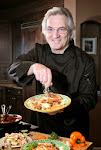Here I go with the French terminology again. “Everything in its place” is the translation of the culinary law that has no exceptions: mise en place (pronounced meez uhn plahss).
Having everything in place when you’re cooking or baking is probably the No. 1 “secret” to success in the kitchen.
When giving private cooking lessons, I’ve seen my pupils running around their kitchens, searching for items in the recipe while a pot is boiling over or onions are burning in the sauté pan. This is not acceptable. And I don’t mention it or drill in it, until I see it happen. And it never fails to happen.
Yes, I know it’s your home kitchen and in your kitchen, you’re the boss. But why would you deliberately make things harder on yourself?
Everything in its place.
It goes without saying that recipes are, in a sense, formulas. In fact, in baking, formula is the term, rather than recipe because, as we all know: cooking is an art; baking is a science.
Nevertheless, the reason I and others more skilled than I write recipes that call for a tablespoon of this and a teaspoon of that, and a whisk and a knife, and so on and so forth, is that these are the ingredients and the implements that should be on the counter, ready to go. And that goes without exception.
Part of mise en place is the advance preparation of ingredients so that, for instance, a pan is not heating while you’re still chopping something. Chopping, dicing and mincing vegetables can be done while the oven is preheating. The pans you need should be out of the cabinet and ready to be placed on the stove top. The knife or knives should be sharp and ready for duty. (Remember: the most dangerous thing in your kitchen is a dull knife.)
In culinary school and in culinary competitions, unlike your home kitchen, the various cuts of vegetables, fruits and herbs are very precise. So a budding chef will have to learn the difference between a large dice and a fine dice; a mince and a small dice; a tourné and a batonette, and so on.
But you don’t. While the culinary student will be judged on his or her precision in making the aforementioned cuts, you need only approximate these. I promise you that it will taste the same. It may not look the same. But it will taste the same.
Everything in its place. Mise en place.
Cookware and bakeware must be appropriate. As a home cook, no one expects you to know the difference between a sauteur and a sauteuse. This is not a hierarchical French kitchen. It’s your home.
But knowing the difference between a pan with higher sides and a pan with sloped sides can make a huge difference in the way your ingredients cook up. This, too, is part of mis en place. If you want your diced vegetables to sauté rather than sweat or steam, then you must choose the correct pan. After all, when you’re expecting crisp and you get limp, don’t blame the pan. Blame the cook who didn’t do proper mise en place.
If I seem a bit pedantic about all of this, it’s because I had it drilled into me on the very first day I walked into the classroom (and for many days afterward) and my chef spent hour upon hour talking about mise en place.
And so it became a habit that is ingrained in me and I hope, if you’re serious about what you do in your kitchen, that it will become ingrained in you as well.
Follow me on Twitter. I'm KitchenGuyMT.
Friday, April 16, 2010
Subscribe to:
Posts (Atom)
